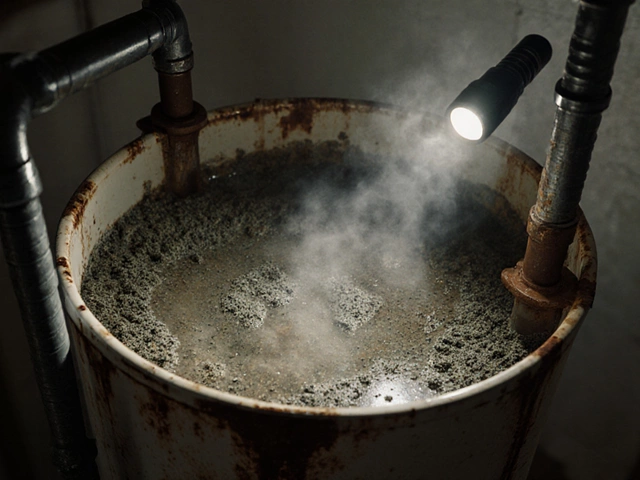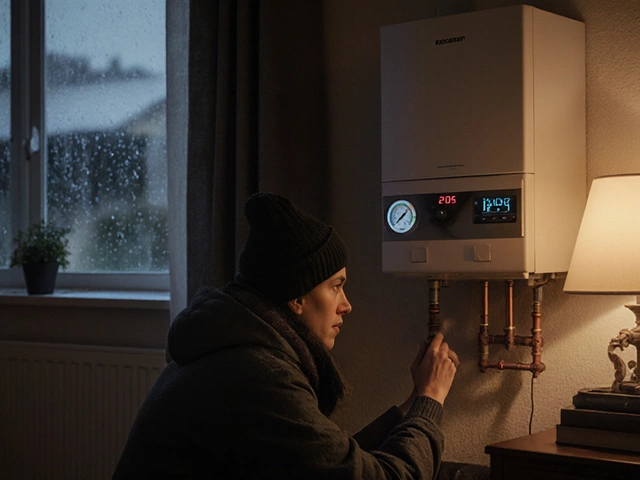Extractor fans often go unnoticed until they stop working, but they play a critical role in maintaining home air quality. This is especially true in kitchens and bathrooms where moisture and odors are prevalent. When these mighty machines falter, homeowners face the question: do you fix it yourself or lean on an electrician's expertise?
It's not just about twisting a few wires together—there's a bit more to think about. From the potential for electrical shock to local building codes, deciding between DIY and calling a pro requires weighing safety, complexity, and comfort with electrical tasks. Understanding what each involves can illuminate the path forward.
In this article, we'll unravel the mystery surrounding extractor fans, highlight key safety guidelines, and provide guidance on when professional intervention might be necessary. For those feeling bold, you'll find practical tips and steps to tackle a replacement on your own. Ready to dive in?
- Understanding the Role of an Extractor Fan
- Safety Considerations and Legal Requirements
- DIY Replacement: Tools and Step-by-step Guide
- When to Call an Electrician
- Tips for Choosing the Right Extractor Fan
Understanding the Role of an Extractor Fan
The humble extractor fan is an indispensable yet often overlooked appliance in many homes. These fans are essential in removing unwanted moisture, smoke, and odors from kitchens and bathrooms. They serve as the lungs of your house, ensuring that fresh air circulates freely while taking away pollutants and excess humidity. Over time, unchecked moisture can lead to mold growth, creating a breeding ground for allergens and adversely affecting indoor air quality. This is where the exhaust fan comes into play, acting as a deterrent against such unpleasant developments.
Extractor fans work by drawing in air from the room and expelling it outside. This helps to maintain a balanced atmosphere and protects the structural integrity of your house. In places like bathrooms, where steam from showers can create an abundance of humidity, these fans play a crucial role in preventing water damage to walls, ceilings, and fixtures. The same principle applies in kitchens, where cooking can release smoke and aromatic compounds that linger if not properly ventilated.
According to the Environmental Protection Agency, 'Proper ventilation improves indoor air quality by diluting and removing pollutants from indoor sources.'Indeed, they agree that efficient ventilation is critical in maintaining a healthy living environment.
The Mechanism Behind Extractor Fans
Understanding the basic mechanism of these devices can empower homeowners when it comes to maintenance and repair. An extractor fan typically comprises a motor, a set of blades, and often a filter to capture larger particles. When the fan is turned on, the motor rotates the blades, creating airflow which is directed outside through ductwork. Some systems include filters that need regular cleaning or replacement to maintain efficiency. Advanced models might also feature adjustable speeds, humidity sensors, and timer functions to enhance their utility.
While their operation might seem straightforward, extractor fans are complex appliances that require adequate care. Neglecting their maintenance can lead to persistent issues, such as overheating and decreased air quality, that aren't easily detected until bigger problems arise. Considering these factors underscores why understanding the extractor fan’s role and proper maintenance is paramount.
Besides that, efficiency ratings and energy consumption are also critical considerations, especially for those seeking to minimize their environmental footprint. By selecting energy-efficient models and employing them thoughtfully, you can reduce energy use while maintaining optimal home conditions. Recent advancements in technology have greatly enhanced the efficiency and effectiveness of these devices. Choosing the right type based on personalized needs can significantly change the comfort and healthiness of one's living environment.
Overall, extractor fans are more than just spinning blades—they are pivotal in crafting a safe and comfortable home atmosphere, shielding residents from the ill effects of excess moisture and lingering odors. Understanding their role and ensuring they operate correctly is essential, illustrating why some homeowners may need to weigh the benefits of DIY replacement against hiring an electrician.
Safety Considerations and Legal Requirements
When it comes to replacing an extractor fan, safety is paramount. The potential for electrical shocks is a serious concern, particularly in wet environments like bathrooms and kitchens. Even seasoned DIY enthusiasts might be hesitant to dabble in jobs that involve electricity, given that improper handling can lead to severe injuries or even fires. A significant safety consideration is ensuring that circuits are properly shut off at the breaker box before any work begins. Double-checking this step can sometimes be the difference between a simple fix and a dangerous mishap.
Beyond the immediate physical risks, there are important legal requirements to consider when replacing extractor fans. Compliance with local building codes is essential, as these regulations are designed to ensure the safety and efficiency of electrical installations. Homeowners should familiarize themselves with the codes in their area, which might dictate the type of fan, the permissible noise levels, or the energy efficiency standards that need to be met. It's wise to consult these legal stipulations before embarking on a home improvement project, as non-compliance can lead to fines or issues when selling the property later on.
In the UK, for example, Part P of the Building Regulations emphasizes that certain electrical work must be carried out or checked by a qualified electrician. While changing a simple fan might seem trivial, when it involves specific installations near a water source, the risks heighten and regulations often dictate professional involvement. Considering these aspects can save homeowners from potential legal hassles and ensure that installations are both safe and up to code. A DIY repair isn't always as straightforward as it seems. Understanding both safety and legal contexts is essential for a hassle-free experience.
"Safety doesn't happen by accident." - A popular safety mantra underscores the importance of proactive measures and awareness when handling electrical components, reinforcing why due diligence is crucial.

DIY Replacement: Tools and Step-by-step Guide
Tackling the replacement of an extractor fan yourself can be a rewarding project. It allows you to save money, learn new skills, and have the satisfaction of solving problems hands-on. But before diving into the task, it's essential to gather the right tools and understand each step involved. This journey isn't just about unscrewing and re-screwing; it requires patience, some know-how, and careful planning. First things first, ensure you have adequate protective gear like safety goggles and gloves because precaution is key when dealing with electrician tools, even if it seems like a straightforward task at first glance.
Begin by compiling a toolkit. The essentials include a screwdriver set, wire strippers and cutters, a voltage tester to ensure there's no current running through the wires, and a utility knife. Having an adjustable wrench and a drill might come in handy if your fan is mounted with brackets that require them. A flashlight or headlamp is useful too, especially if you're in a small space or limited lighting, like a bathroom without windows. Don’t forget the new extractor fan. Ensure it matches the specifications of the old one or adds an improvement in ventilation. Each of these tools plays a crucial role and knowing when and how to use them is part of the learning curve.
Once equipped, it's time to dive into the steps involved. Start by turning off the power source to the fan at the breaker box to avoid any risk of electrical shock. After confirming the power is off using the voltage tester, carefully remove the old fan. This typically involves unscrewing the cover plate and disconnecting any wiring, keeping a note of which wire goes where, or taking a picture for reference. As the old saying goes, ‘a picture is worth a thousand words’ – it might just save you a thousand headaches later on as you connect your new purchase.
"Safety is not a gadget but a state of mind." - Eleanor Everet
Next, inspect the ductwork for any signs of wear or obstruction. This is crucial as any hindrance here can compromise the functionality of your new fan. Once satisfied everything is in order, begin installing the new fan. Secure it in place, connect the wires (being careful to match the previous setup using your notes or pictures), and fit the cover plate. Each nook and cranny should be tightly aligned, ensuring there's no gap for unwanted air to escape or debris to enter.
Before calling it a day and patting yourself on the back, double-check all connections. Once you've gone over everything, restore power at the breaker and test run your installed fan to make sure it operates smoothly. Listen for any unusual sounds and feel for efficient airflow, indicative of a successful installation. If it needs adjustments, don’t hesitate to tweak it. Understanding when to trust your instincts or when to backpedal for safety adjustments speaks volumes about prudence in managing DIY home improvements.
When to Call an Electrician
Deciding when to call an electrician for replacing an extractor fan can feel like walking a tightrope. It's a balancing act of understanding the complexity of the task, adhering to local electrical codes, and prioritizing safety. While it may be tempting to grab a toolbox and tackle the job, certain situations clearly signal it's time to pick up the phone and bring in the professionals. Professional electricians are trained to diagnose the issues that aren't easily visible to the untrained eye. For instance, they can assess the condition of the electrical wiring, which is crucial because improper or faulty wiring can be a silent hazard lurking behind your walls. Ignoring such signs can lead to bigger problems down the line, including fire risks or short-circuit issues that could compromise the safety of your home and loved ones.
Many homes, especially older ones, have outdated electrical systems that might not support the energy requirements of modern extractor fans. If you're uncertain about the compatibility of your current setup with the new fan, contacting a licensed electrician is wise. They can ensure that your electrical panel can handle the added load without any risks. Additionally, working with electricity involves inherent risks, especially for those who are inexperienced. Electricians utilize specialized tools and techniques that virtually eliminate the risk of shocks or other accidents.
According to the U.S. Consumer Product Safety Commission, there are nearly 400 electrocutions in the U.S. every year. Seeking professional expertise can help reduce this statistic.A failure to consider these factors can lead to costly repairs, and in some cases, can void warranties on new appliances if they are not installed properly. Also, local building codes and regulations often demand that certain electrical tasks be performed or at least inspected by a professional. Compliance ensures that the work meets safety standards, which can affect homeowners' insurance policies in case of damage claims related to electrical issues.
In some areas, attempting a DIY repair might actually require a permit, adding another layer of complexity. When these situations arise, having a certified electrician makes the process smoother since they are well-versed in these procedural nuances. For those who are all thumbs when it comes to handling electrical gadgets, relying on a professional ensures peace of mind and guarantees that the heart of your home remains secure. Hiring an electrician is more than just paying for a service; it is investing in the safety and efficiency of your living space.

Tips for Choosing the Right Extractor Fan
Choosing the right extractor fan for your home isn't just about picking the first one you see on the shelf. There are many factors to consider, each playing a crucial role in ensuring that your new fan meets your household's specific needs effectively. Start by assessing the room where you'll install the fan. Is it a kitchen that sees frequent cooking adventures or a smaller bathroom where steam accumulates after every shower? The type of room often determines the power and size of the fan you need. Larger spaces typically require fans with higher cubic feet per minute (CFM) ratings to ensure that air doesn't just move in circles but actually exits the room effectively, taking all unwanted odors or moisture with it.
Beyond the physical space, pay attention to noise levels. It's easy to overlook, but trust me, you'll notice when your fan sounds like a jet taking off every time you flip the switch. Look for models labeled as 'quiet' or those with a sone rating of two or less—this is the sweet spot where performance meets peace. For those who crave quietude but still want efficiency, there are ultra-quiet models on the market, though they might stretch your budget a bit. An overlooked benefit, some newer models even feature humidity sensors that activate automatically, ensuring that your fan does its job without you even lifting a finger, keeping the air as fresh as a daisy.
Taking sustainability into account, modern extractor fans have embraced the green revolution. Energy-efficient models not only save on electricity bills but they're also kinder to the planet—a win-win. These fans often feature timers or automatic shut-off functions, ensuring they run only as long as necessary, trimming down electrical use without sacrificing effectiveness. Keep an eye out for Energy Star-rated equipment, as these often guarantee both performance and efficiency. For the eco-warriors out there, some models use recycled materials showing that even household appliances can step up for the environment.
Of course, the aesthetic aspect can't be ignored, particularly if the fan will be visible from common areas. Manufacturers have picked up on the trend, with stylish designs that range from sleek and minimalist to units that resemble art pieces. Whether you want your fan to blend in seamlessly or stand out as a conversation starter, there's something in the market to match your decor. As celebrity designer John Doe says, "Function doesn't have to compromise on style; in fact, the best designs marry the two effortlessly."
"A well-chosen fan not only serves its practical purpose but can also be a subtle design statement," says Jane Smith, an expert from Home Design Magazine.
Lastly, consider the installation process. Some models are straightforward and almost beg to be handled by DIY enthusiasts, while others might require the deft hands of a professional electrician, particularly when dealing with complex or outdated wiring systems. Look for models that come with clear instructions and compatibility guides to avoid potential headaches. Online customer reviews are also a gold mine of real-world insights into ease of use and any challenges others have faced, providing a clearer picture of what to expect post-purchase. Given these considerations, you'll have a shiny new extractor fan happily humming along and serving its purpose efficiently.





